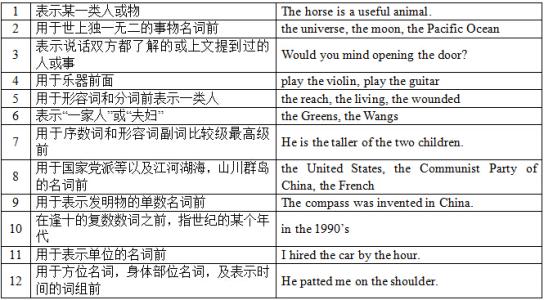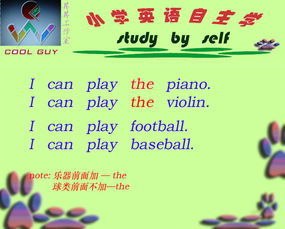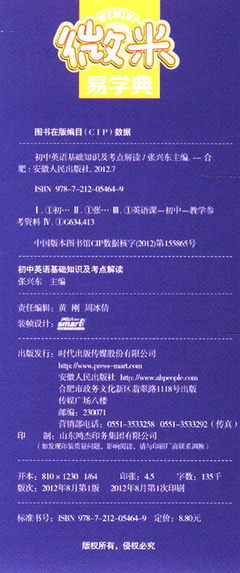一,概述
冠词是一种虚词,一种辅助性的词,不可在句中独立担当一个成分,要放在名词前,帮助说明名词的含义。
冠词有不定冠词(a, an)和定冠词(the)两种。
1.定冠词the,在以辅音音素开头的词前读作[TE], 在以元音音素开头的词前读作[Ti], 强调时读作[ Ti:]。
例:the table [TE 5teibl]那张桌子
the animal [Ti 5AnimEl]那只动物
2.定冠词the,基本含义是“这个,那个”,表示特指。
例: the flower 那朵花 the E-mail 那个电子邮件
3.不定冠词a和an,基本含义是“一、一个”,表示泛指。
例:a flower 一朵花 an E-mail 一个电子邮件
二,a 和an 的区别
a用在辅音音素前,包括以前元音[j]、[w]开首的词前,读作[E],强调时读作[ei]。注意,这里讲的辅音音素指的是发音,不是指辅音字母。
an用在元音音素前(不是元音字母),读作[En], 强调时读作[An]。
例:a hotel [hEu5tel]一家旅馆
a knife [naif] 一把小刀
a useful tool [5ju:sful] 一件有用的工具
a university [7ju:ni5vE:siti] 一所大学
a European country [7juErE5pi(:)En] 一个欧洲国家
a one-eyed man ['wQn5aid] 一个一目失明的人
an hour [5auE] 一小时
an ant [Ant] 一只蚂蚁
an honour [5CnE] 一种荣誉
an honest boy [5Cnist] 一个诚实的男孩
an umbrella [Qm5brelE] 一把伞
an onion [5QnjEn] 一个洋葱
an eye [ai] 一只眼睛
an ear [iE] 一只耳朵
an English book [5iN^liF] 一本英语书
an egg [e^] 一只鸡蛋
an apple [5Apl] 一个苹果
an island [5ailEnd] 一座岛
an uncle [5QNkl] 一位叔叔
an old man [Euld] 一位老人
an elephant [5elifEnt] 一头大象
a D [di:] 一个D (B、C、G、J、K、P、Q、T、U、V、W、Y、Z前也用a)
an F [ef] 一个F(A、E、H、I、L、M、N、O、R、S、X前也用an)
三,不定冠词的用法
1 表示“一,一个”,用在单数可数名词前
例:There is a picture on the wall. 墙上有一幅图画。
He has an apple in his hand. 他手里拿着一个苹果。
提示
a. a (an) 虽表示“一个”,但不强调数量,而是强调类别;one则强调数量。
例:I bought a computer. 我买了一台电脑。(不是收音机和电视机)
I bought one computer. 我买了一台电脑。 (不是两台)
Would you like an ice cream? 来一客冰淇淋好吗?(不是别的食物)
She gave one ice cream to them each. 她给他们每人一客冰淇淋。(不是两客)
b. 表示数量对比时,要用one, 不用a(an)。
比:我有一支红铅笔,但是他有三支。
I have a red pencil, but she has three. (误)
I have one red pencil, but she has three. (正)
我只需要一美元,但他给了我两美元。
I only want a dollar, but he has given me two. (误)
I only want one dollar, but he has given me two. (正)
2 表示一类人或物,指同类中的任何一个,a或an不必翻译
例 Even a child can answer this question. 就是小孩子也能回答这个问题。
An elephant is stronger than a horse. 大象比马力气大。
A teacher must be strict with his students. 教师必须对学生严格要求。
3 第一次提到某人或某物
第一次提到某人或某物时,用不定冠词a或an,起介绍作用。
例: A girl wants to see you. 一位姑娘要见你。
On a cold evening a stranger came to my house. 在一个寒冷的晚上,一个陌生人来到我的住处。
4 表示身份、职业
不定冠词用于单数名词前表示身份、职业,尤其用在作表语或补足语的名词前。
例:She is a high school teacher. Her name is Li Fang. 她是一位中学教师,名叫李芳。
The Whites wanted their daughter to be a musician. 怀特夫妇想要他们的女儿成为音乐家。
提示
表示某个职位在某一时期内只有一人担任,或表示某人的头衔,则不用冠词。
例:He is captain of the team. 他是球队队长。
Zhang Fei, monitor of their class, is good at English. 张飞是他们的班长,英语很棒。
5 用于专有名词前,表示不认识某人
例:A Zhang called you just now. 一位姓张的刚才给你打电话。
A Mr. Smith wanted to see you. 有位史密斯先生想要见你。
6 不定冠词用在表示数量、长度、时间等的计数单位的名词前,表示“每一”
例:We have three meals a day. 我们每天吃三顿饭。
They met each other once a month. 他们每月会面一次。
The car moved 100 miles an hour. 这辆小汽车以每小时100英里的速度行驶。
The envelopes are one yuan a dozen. 信封一打是一元钱。
Amily goes to see her grandmother twice a week. 爱米莉每周去看奶奶两次。
7 用于某些结构中
不定冠词用在下列结构中:
结构:
such a +单数可数名词
quite a +单数可数名词
rather a+单数可数名词
例:It is such a fine day. 多么晴朗的一天。
He is quite an honest man. 他是个非常诚实的人。
He is rather a gentleman. 他真是一位绅士。
提示
名词前若有形容词修饰,不定冠词a (an)可以放在quite, rather前面或后面。
例: It is rather a difficult problem. 这是相当难的一个问题。
It is a rather difficult problem.
8 用于某惯用短语中
例:have a cold 患感冒
have a rest 休息一下
have a swim 游泳
have a fever 发烧
have a quarrel 吵架
have a toothache 牙痛
have a dance 跳舞
have a talk 谈话
go for a walk 散步
take a bath 洗澡
tell a lie 撒谎
wait a moment 等一会儿
with a light heart 愉快地
with a smile 微笑着
with an effort 努力地
as a result 因此
for a while 一会儿
once in a while 偶尔
for a moment 一会儿
have a word with sb. 同某人谈话
have a try 试一下
have a good time 玩得高兴
have a look 看一看
have a headache 头痛
have a good sleep 好好睡一觉
have a nice trip 旅途愉快
have(/take) a walk 散步
make a face 做鬼脸
in a hurry 匆忙地
do sb. a favour 帮某人忙
take an active part in 积极参加
live a happy life 过幸福生活
give a lesson 教一堂课
at a time 每次
as a whole 作为整体
all of a sudden 突然
once upon a time 从前
in a word 总之
9 不定冠词与so, as, too, how等连用时的位置
如果修饰名词的形容词前有so, as, too, how等副词,不定冠词一般放在形容词和名词之前。
结构:
so
as
too
how
+形容词+ a(an) +名词
例:He is as clever a boy as Tom. 他是像汤姆一样聪明的孩子。
It is so high a wall that we can't climb it. 这堵墙非常高,我们爬不上去。
How beautiful a bird it is! 这是一只多漂亮的鸟啊!
It is too wide a rive for me to swim across. 这条河太宽,我游不过去。
It too difficult a book for beginners. 这本书对初学者来说太难了。
I've never seen so tall a tree. 我从没见过这么市制树。
=I've never seen such a tall tree.
提示
half 常放在不定冠词前,但在美国英语中,half也可放在不定冠词后。
例: half an apple 半个苹果
a half apple
half a day 半天
a half day
half an hour 半个小时
a half hour
half a mile 半英里
a half mile
四,定冠词the 的用法
1 表示“一,一个”,用在单数可数名词前
例:There is a picture on the wall. 墙上有一幅图画。
He has an apple in his hand. 他手里拿着一个苹果。
提示
a. a (an) 虽表示“一个”,但不强调数量,而是强调类别;one则强调数量。
例:I bought a computer. 我买了一台电脑。(不是收音机和电视机)
I bought one computer. 我买了一台电脑。 (不是两台)
Would you like an ice cream? 来一客冰淇淋好吗?(不是别的食物)
She gave one ice cream to them each. 她给他们每人一客冰淇淋。(不是两客)
b. 表示数量对比时,要用one, 不用a(an)。
比:我有一支红铅笔,但是他有三支。
I have a red pencil, but she has three. (误)
I have one red pencil, but she has three. (正)
我只需要一美元,但他给了我两美元。
I only want a dollar, but he has given me two. (误)
I only want one dollar, but he has given me two. (正)
2 表示一类人或物,指同类中的任何一个,a或an不必翻译
例 Even a child can answer this question. 就是小孩子也能回答这个问题。
An elephant is stronger than a horse. 大象比马力气大。
A teacher must be strict with his students. 教师必须对学生严格要求。
3 第一次提到某人或某物
第一次提到某人或某物时,用不定冠词a或an,起介绍作用。
例: A girl wants to see you. 一位姑娘要见你。
On a cold evening a stranger came to my house. 在一个寒冷的晚上,一个陌生人来到我的住处。
5 用在表示方向、方位的名词前
这类词有:
the east东方,the west西方,the south南方,
the north北方,the right右边,the left左边
例:The birds are flying to the north. 这些鸟向北方飞去。
The moon rises in the east and sets in the west. 月亮从东方升起,在西方落下。
The wind was blowing from the south. 风从南方吹来。
She lived to the west of the Summer Palace. 她住在颐和园的西边。
Walk along the road and take the first turning on the right. 沿着这条路往前走,在第一个路口往右拐。
He stood at the back of the door. 他站在门背后。
提示
方位词成对使用构成平行结构时,不用定冠词。
例:The river is two thousand kilometers long from west to east. 这条河自西向2000公里长。
They traveled through the country from south to north. 他们自南向北在这个国家旅行。
6 用在形容词最高级前
例:Summer is the hottest season of the year. 夏天是一年中最炎热的季节。
She is the best person for the job. 她是最适合这个工作的人。
Hangzhou is one of the most beautiful cities in the world. 杭州是世界上最美的城市之一。
The car is the most expensive of the four. 这部车是四部车中最贵的。
7 用在序数词等前
定冠词用在序数词前,也用在表示序列的next, last等前,还有在表示“同一”或“唯一”等的词前。
例:The first man to land on the moon is an American. 第一个登上月球的人是美国人。
She was the fifth to climb to the top of the mountain. 她是第五个到达山顶的人。
This may be the last chance. 这可能是最后一次机会。
If I miss this train I'll catch the next one. 如果赶不上这趟火车,我就赶下一趟。
He is the only person who knows the secret. 他是唯一一个知道这个秘密的人。
The two coats are of the same colour. 这两件外衣颜色相同。
This is the very book I want. 这正是我要的书。(用very表示强调)
提示
a 序数词表示“又一”时,前面用不定冠词a(an)
例:He bought a second pair of shoes. 他又买了一双鞋。
He asked a question, then a second, then a third…他问了一个问题,又问了第二个,第三个……
b 序数词用作状语或表语时,前面不加定冠词。
例:George arrived first. 乔治第一个到。
=George was the first person to arrive.
Jim and Jack are both second in the match. 汤姆和杰克在比赛中并列第二。
8 用在单数名词前表示一类人或物,强调整个类别
例:The orange is a kind of fruit. 橘子是一种水果。
The horse is a useful animal. 马是一种有用的动物。
The computer is important to us. 电脑对我们来说是重要的。
提示
不定冠词+单数名词,不带冠词的复数名词也可表示一类人或物。
例:A car runs faster than a bus. 小汽车比公交车跑得快。
Cars run faster than buses.
A dog is a faithful animal. 狗是忠实的动物。
Dogs are faithful animals.
9 用在乐器名词前,表示演奏
例:She can play the piano. 她会弹钢琴。
He plays the violin very well. 他小提琴拉得很好。
He played the guitar for the children. 他给孩子们弹了吉他。
提示
但乐器名词表示具体的器物,或表示课程时,不加the.
例:He bought a piano last month. 他上个月买了一架钢琴。
She taught piano in the school. 她在学校里教钢琴。
10 用在江河、海洋、湖泊、群岛、山脉的名称前
例:the Yangtze River 长江
the Red Sea 红海
the West Lake 西湖
the Pacific 太平洋
the Himalayas 喜马拉雅山
the Nile 尼罗河
the Rocky Mountains 落基山脉
the South China Sea 南中国海
提示
例外的情况:
Mount Tai 泰山
China Daily 《中国日报》
11 用在由普通名词和另外一些词构成的专有名词前
例:the Great Wall 长城
the United Nations 联合国
the New York Times 《纽约时报》
the United States of America 美国
the Red Cross Hospital 红十字医院
the Olympic Games 奥林匹克运动会
the Shanghai Railway Station 上海火车站
the People's Republic of China 中华人民共和国
the North Pole 北极
the People's Daily 《人民日报》
12 用在某些形容词前,表示一类人或物或某种抽象概念
例: the old 老年人
the happy 幸福的人
the poor 穷人
the aged 老人
the sick 病人
the impossible 不可能的事
the young 年轻人
the rich 富人
the blind 盲人
the wounded 伤员
the smooth 顺事
the beautiful 美,美的东西
The rich should help the poor. 富人应该帮助穷人。
The good is what people like. 人们总是喜欢美好的东西。
The wounded have been sent to the hospital. 伤员已经被送到医院去了。
13 用在姓氏的复数形式前,表示全家人或这一姓的夫妇二人
例:The Greens will more to the country. 格林一家要搬到乡下去。
The Wangs came to see us yesterday. 王家一家人昨天来看我们。
The Browns are very friendly. 布朗夫妇都很友好。
14 用在表示计算单位的名词前,含有“每,每一”的意思
例:Jim is paid by the hour. 吉姆的工资按小时付。
Eggs are sold by the kilogram. 鸡蛋按千克出售。
This cloth is sold by the yard. 这种布按码出售。
It sells at three dollars the pound. 它以每磅三美元出售。
They sell sugar by the pound. 他们按磅卖糖。
15 用在前面已提到过的人的身体部位或衣着的名词前
这种用法是先把整个对象说出来,然后再说到那个对象的身体的局部或衣着。
结构:
动词(hit, pull, pat, strike, catch, hold, take)
+sb. +介词(in, on, by, across)+身体部位或衣着
例:She touched him on the shoulder. 她碰了碰他的肩。
He took the girl by the hand. 他拉着小女孩的手。
He hit her on the nose. 他打了她的鼻子。
The stone struck the man in the eye. 石头击中了那人的眼睛。
I caught her by the right hand. 我抓住她的右手。
比:她拍了拍那男孩的头。
She patted the boy on his head. (误,本结构中身体部位或衣着前不用one's)
She patted the boy on the head. (正)
16 用在逢十的复数数词前,表示年代,也指人的大约岁数
例:The war broke out in the forties. 那场战争发生在40年代。
He went abroad in the 1980s. 他在20世纪80年代出国的。
The old man is in the seventies. 老人大约七十几岁。
17 用在表示自然现象的名词前
这类名词有:
the rain 雨,the wind风, the fog雾,the snow雪,
the air空气, the storm风暴,the snowstorm 暴风雪
例:Don't stand in the rain. 不要站在雨中。
The wind blew down the trees. 风把树刮倒了。
The ship sank in the storm. 船在风暴中沉没了。
The rain has cleaned the air. 下雨净洁了空气。
The fog was so thick that we couldn't see the top of the hill. 雾很大,我们看不见山顶。
提示
a 这类名词前有形容词修饰时,可用不定冠词,表示“一场,一阵,一种”
例:A cold wind is blowing from the north. 冷风从北方吹来。
There was a heavy rain last night. 昨晚下了一场大雨。
A heavy snow is falling outside. 外面正下着大雪。
b 这类名词表示一般物质时,不用冠词。
例:Rain falls in summer; snow falls in winter. 夏天下雨,冬天下雪。
Man can't live without air. 没有空气人不能活。
18 用在某些习惯用语中
例:
in the morning 在上午
in the evening 在晚上
in the field 在田野里
in the country 在乡间
in the sun 在阳光下
in the distance 在远处
on the right 在右边
by the way 顺便说一下
in the front of 在前部
in the daytime 白天
go to the concert 去听音乐会
at (/in) the beginning 开始
at the moment 当时,此刻
all the year round 一年到头
go to the cinema 去看电影
go to the theatre 去看戏
at the weekend 周末
in the afternoon 在下午
in the night 在夜里
in the sky 在空中
in the dark 在暗处
in the rain 在雨中
in the shade 在阴凉处
on the left 在左边
all the time 始终
in the middle of 在中间
on the way home 回家途中
all the same 依然
on the whole 总之
at the same time 同时
on the plane 在飞机上
in the year 2008 在2008年
the other day 前几天
at the bottom of 在……底部
in the end 终于
on the one hand, on the other hand 一方面,另一方面
提示
下面几个短语前不加定冠词:
例:at dawn 在黎明
at night 在晚上
at noon 在正午
at dusk 在黄昏
五,名词前不用冠词的情况
1 专有名词前不用冠词
专有名词前不用定冠词,包括人名、地名、月份、周日、节日等。
例:
月份
January 一月
May 五月
October 十月
周日
Monday 星期一
Friday 星期五
Sunday 星期天
季节
spring 春天
summer 夏天
autumn 秋天
winter 冬天
节日
Christmas Day 圣诞节
New Year's Day 元旦
New Year's Eve 除夕
National Day 国庆节
Teacher's Day 教师节
人名
Mary 玛丽
Jones 琼斯
Mr. Brown 布朗先生
Porfessor Smith 史密斯教授
地名
Asia 亚洲
China 中国
Britain 英国
Beijing 北京
New York 纽约
Shanghai Road 上海路
Tian An Men Square 天安门广场
Spring is coming. 春天就要到了。
These birds fly to the south in winter. 这些鸟冬天飞往南方。
She came on Friday. 她星期五来的。
提示
a 如果月份、季节名词带有修饰语,表示特定的时间,要加定冠词。季节名词在上下文中表示特定的一段时间,要加定冠词。
例:They built the bridge in the spring of 2003. 他们是在2003年的春天修建这座桥的。
The fire broke out on the Friday when they were not at home. 失火是在星期五,当时他们不在家。
These animals eat nothing all through the winter. 这些动物整个冬天都不吃东西。
b 但要说the Spring Festival(春节),以festival组成的节日名称前要加the.
例:the Mid-autumn Festival 中秋节
the Dragon-boat Festival 端午节
2 物质名词表示一般概念时,不用冠词
例:Water boils at 100℃. 水在摄氏100度沸腾。
Rice is grown in the south. 南方种水稻。
They are short of food. 他们缺少食物。
提示
a 如果物质名词表示特指或有定语修饰,则要加定冠词。
比:Snow is falling hard. 雪正下得很大。
The snow in the field has melted. 田里的雪已经融化了。
She likes milk very much. 她非常喜欢喝牛奶。
The milk in the bottle has gone sour. 瓶里的牛奶酸了。
b 物质名词用于表示“一客、一杯、一份、一种、一阵”时,要用不定冠词。
例:I'd like an ice cream. 我要一客冰淇淋。
A tea and two coffees, please. 请来一杯茶、两杯咖啡。
There was a heavy rain this morning. 今天早上下了一场大雨。
3 抽象名词表示一般概念时,不用冠词
例:Friendship is more important than money. 友谊比金钱更重要。
Does he like music? 他喜欢音乐吗?
Knowledge is power. 知识就是力量。
Failure is the mother of success. 失败乃成功之母。
提示
a 抽象名词有定语修饰,表示特指时,要加定冠词。
例:I like the music of the TV play. 我喜欢这部电视剧中的音乐。
b 抽象名词表示“一种,一类,一次,一番,一例”等概念时,要加不定冠词。
例:Maths is a science. 数学是一门科学。
He lives a happy life. 他过得幸福的生活。
She has a good knowledge of English. 她精通英语。
Let's go for a swim. 我们去游泳吧。
He had a wash first. 他先洗了洗。
4 表示一日三餐的名词前不用冠词
例:I usually have breakfast at seven. 我通常在七点钟吃早饭。
He doesn't have lunch at home. 他通常不在家吃午饭。
Dinner is ready. 饭准备好了。
提示
a 三餐名词前有定语修饰时,特指某一餐,要用不定冠词。
例:We had a wonderful lunch. 我们吃了一顿很丰盛的午餐。
They had a nice dinner last night. 他们昨晚吃了一顿丰盛的饭。
b 表示某一次具体的餐食,要用定冠词。
例:The lunch was cooked well. 那顿午饭做得很好。
Did you enjoy the dinner at his house? 他家的饭你喜欢吗?
c meal 常同不定冠词连用,泛指一顿饭。
例:She cooks a hot meal in the evening. 晚上她总会烧一顿热饭。
He had a big meal at his uncle's. 他在叔叔家大吃了一顿。
5 表示体育运动、棋牌的名词前不用冠词
例:He plays football after school. 他放学后踢足球。
The students are playing basketball over there. 学生们在那边打篮球。
He is good at playing chess. 他象棋下得好。
They play cards on Sundays. 他们常有星期天打牌。
6 表示学科、语言的名词前不用冠词
例:She teaches English in a middle school. 她在一所中学教英语。
Chemistry is not easy to learn. 化学不容易学。
Can you speak Japanese? 你会说日语吗?
We have Chinese and mathematics in the morning. 我们上午学习语文和数学。
7 表示称呼语、职位、头衔的名词前不用冠词
例:Where are my shoes, mom? 我的鞋在哪里,妈妈?
Tom, go and fetch some water. 汤姆,去弄点水来。
Now children, listen to me carefully. 孩子们,请认真听我讲。
Mr. Xu teaches us maths. 徐老师教我们数学。
President Li will come to our class. 李校长将来我们班。
He was once mayor of the city. 他曾经是这个市的市长。
They made him monitor. 他们让他当班长。
John was captain of the team. 约翰是队长。
8 某些交通工具名称前不用冠词
by train 乘火车(=on a train)
by ship 乘船(=on a ship)
by taxi 乘出租车(= in a taxi)
by plane 乘飞机(=on a plane)
by bus 乘公交车 (=on a bus)
by bike 骑自行车 (=on a bike)
by car 乘小汽车(=in a car)
on foot 步行
例:I go to school by bike. 我骑自行车上学。
Did you go by air? 你坐飞机去的吗?
They came by land. 他们由陆路来的。
The goods will be sent there by water. 货物将由水路运往那里。
提示
表示邮寄方式的名词前也不用冠词。
例:He sent the letter by air mail. 这封信他寄了航空。
9 go to school 和 go to the school
某些个体名词,如:school, church, hospital, bed, prison, table等,表示抽象意义或相关的活动时,不加冠词;而如果表示具体地点,则要加定冠词。
例:The children go to school at seven every morning. 孩子们每天早晨7点钟上学。
Father went to the school to see Mr. Chen. 父亲去学校看望陈老师。
I go to bed at about eleven. 我大约11点钟睡觉。
He sat on the bed and watched TV. 他坐在床上看电视。
They are in church now. 他们正在做礼拜。
I passed the church on my way home. 我回家的路上经过那个教堂。
He was sent to prison for stealing. 他因偷窃而坐牢。
At the end of road you can see the prison. 在路的尽头,你能看见那所监狱。
The Wangs are at table. 王家一家人在吃饭。
Is this the table you bought yesterday? 这就是你昨天买的那张桌子吗?
I went to town to do some shopping yesterday. 我昨天进城购物。
He was born in the town fifteen years ago. 他15年前出生在那座小城里。
He is seriously ill and must be sent to hospital at once. 他病得很重,必须马上送医院。
He is going to the hospital to buy some medicine. 他打算去医院买些药。
go to college 上大学
go to the college 去那所大学(办事)
go to (the) market to buy food 上市场买菜
on the market 出售
提示
a. 在cinema, theatre 前常要用定冠词。
例:She went to the cinema (/movies) once a week. 她每周看一次电影。
They went to the theatre last night. 他们昨晚去看戏了。
He prefers the cinema to the theatre. 他喜欢看电影,不喜欢看戏。
b. in front of 表示“在……前面”,相当于before, 而in the front of 则表示“在某物内部的前部”。
例:The driver saw a boy standing in front of the bus. 司机看见一个男孩站在公共汽车的前面。
The drive sat in the front of the bus. 司机坐在公共汽车的前部。
10 表示一类人或物的复数名词前不用冠词
例:Birds are our friends. 鸟是我们的朋友。
We are fond of sports. 我们喜爱运动。
Teachers should be kind to their students. 教师应该对学生友善。
Boys are usually stronger than girls. 男孩子通常比女孩子力气大。
提示
表示某一类人或物时,可用下面三种方法:
狗是忠实的动物。
The dog is a faithful animal. (用定冠词)
A dog is a faithful animal. (用不定冠词)
Dogs are faithful animals. (用复数形式,不加定冠词)
11 不可说 a my book
名词前有物主代词、指示代词、不定代词、疑问代词或名词所有格时,不可再加冠词。
例:这是我的书。
This is a my book. (误)
This is my book. (正)
汤姆的母亲是一位医生。
The Tom's mother is a doctor. (误)
Tom's mother is a doctor. (正)
Which bus did you take? 你乘哪路公交车?
12 家庭成员名称前不用冠词
mother, father, uncle, aunt 等家庭成员,包括nurse(保姆),当作专有名词用时,不加冠词,但即使不在句首也要大写。
例: Mother is watering the flowers. 妈妈在浇花。
Father has gone fishing. 父亲钓鱼去了。
Uncle bought a toy for me. 舅舅给我买了一个玩具。
Nurse is kissing Baby. 阿姨在亲吻宝宝。
13 两个平行、并列的名词前不用冠词
例:arm in arm 臂挽臂
side by side 肩并肩
father and son 父子
one by one 一个接一个
brother and sister 兄妹
sun and moon 日月
from time to time 时时,不时
from east to west 从东到西
from beginning to end 自始至终
from morning till night 从早到晚
hand in hand 手拉手
face to face 面对面
mother and child 母子
day by day 一天一天的
husband and wife 夫妻
day and night 日日夜夜
step by step 循序渐进
from door to door 挨家挨户
hour after hour 一个小时又一个小时
They are doctor and patient. 他们是医生和病人。
Father and son are playing chess. 父子两人在下棋。
They are walking down the road side by side. 他们肩并肩在路上走着。
Husband and wife are sitting in the room. 夫妻俩在房间里坐着。
14 a singer and dancer 和 a singer and a dancer
两个名词共用一个冠词,表示同一人或物;两个名词前各有冠词时,则表示两个人或物。
比: a black and white cat 一只花猫
a black (cat) and a white cat 一只黑猫和一只白猫
She is a singer and dancer. 她是歌唱家,同时也是舞蹈家。
They are a singer and a dancer. 他们是一位歌唱家和一位舞蹈家。
The teacher and writer has come. 那位教师兼作家已经来了。
The teacher and the writer have come. 那位教师和那位作家已经来了。
It is an English and Chinese dictionary. 这是一本英汉词典。
They are an English and a Chinese dictionary. 它们是一本英语词典和一本汉语词典。
提示
比较下面几组短语的不同含义。
take place 发生,举行
take one's place 代替某人(的工作)
out of question 一定,毫无问题
out of the question 不可能,办不到
on earth 究竟,到底(用于加强语气)
on the earth 在地球上
four of them 他们当中4人(不只4人)
the four of them 他们4人(共计4人)
next week (month) 下周(下个月)(以现在看将来)
the next week (month) 第二周(下个月) (在过去某一时间之后)
The accident took place last night. 这场事故是昨天夜里发生的。
John is too ill to come, so I'm taking his place. 约翰生病了,来不了,所以我将代替他。
It is out of question that he will win the match. 他一定会赢得这场比赛的。
A holiday for me this year is out of the question. 我今天休假是不可能的了。
What on earth do you want? 你究竟要什么?
There are all kinds of living things on the earth. 地球上有各种各们的生物。
He will return next week. 他下周返回。
He returned on May 10th and flew to Beijing the next week. 他五月十号返回的,第二周又飞住北京去了。
There are forty students in the class and four of them are girls. 这个班上有40名学生,其中4名是女生。
Jim, Bob, Lucy and Linda lost their way in the forest and the four of them didn't eat anything for a whole day. 吉姆、鲍勃、露西和琳达在森林中迷了路,4个人一整天都没吃到东西。
15 某些习惯语中不用冠词
例:go to school 上学
at home 在家
on time 准时
at last 终于
in fact 事实上
on holiday 在度假
on duty 值日
at times 有时候
after class 课后
at night 在夜间
by bus 乘公交车
by sea 乘船,走海路
with pleasure 乐意地
with anger 生气地
with kindness 亲切地
go to bed 上床睡觉
in time 按时
at first 起初
lose heart 灰心
on foot 步行
at work 在工作
on show 在展出
in trouble 处于困境
on fire 着火
stay at home 呆在家里
by air 乘飞机
by land 走陆路,由陆路
with joy 高兴地
with difficulty 吃力地

 爱华网
爱华网


